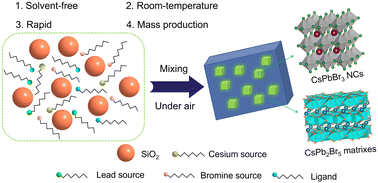Solvent-free synthesis of stable heterostructured-CsPbBr3/Cs2PbBr5 assisted by SiO2 for white light-emitting diodes†
Abstract
Continuously improving the stability of lead halide perovskite nanocrystals (NCs) to meet the requirement of industrialization has received tremendous attention. Phase structure modulation or matrix protection has been proven to be a feasible strategy, but these preparations are still hindered by the usage of organic solvents, complex operations, and unsatisfactory batch reproducibility, conflicting with scaled-up production. Here, we have successfully prepared highly stable cesium lead bromide perovskites with superior luminescence properties (photoluminescence quantum yield, PLQY > 80%) by solid-state synthesis using SiO2 nanospheres as a reaction medium, which present heterostructured-CsPb2Br5/CsPbBr3 (H-CPB). Profiting from the dual-phase structure and SiO2 matrix protection, the as-obtained H-CPB shows high stability with a retained PL of above 90% under continuous UV light irradiation, which is significantly higher than the 42% for the control sample. Importantly, the proposed method features solvent-free, rapid (within 5 mins), and room-temperature synthesis, which could also be used to scale up production evidenced by a batch of 760 g H-CPB powders without compromising their performance. The resulting H-CPB phosphors and commercial red-emitting phosphor coated on blue GaN chips exhibit tunable color temperatures from warm white to cool white, which indicates that the H-CPB perovskites have huge potential for lighting applications.

- This article is part of the themed collections: FOCUS: Perovskite Materials and Devices and FOCUS: Light-emitting diodes technology


 Please wait while we load your content...
Please wait while we load your content...